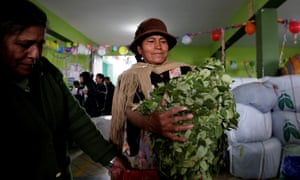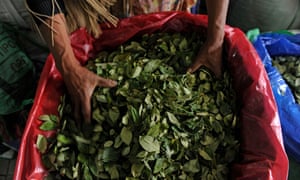Ricardo Hegedus raised his voice so he could be heard over the clanging of tea-packaging machines. “Coca is a marvellous gift of nature, offering a moderate stimulant like coffee – but full of vitamins and minerals,” he said.
Hegedus, the manager of Windsor – Bolivia’s largest coca leaf tea producer – pointed to stacked boxes of teabags and said: “We have dreamt of exporting coca tea for the 26 years I have worked here.”
That vision of an expanding international market for legal coca products – such as flour, tea and ointments – is shared widely in Bolivia, and it was the driving force for a recent law signed this month by president Evo Morales that jacks up the 12,000 hectares (29,640 acres) legally recognized in a 1988 law to 22,000 hectares.
But in most other countries, coca is still best known as the main ingredient in cocaine, and finding a legal market for alternative products has proved challenging.
Government officials admit that they underestimated international resistance, largely because in Bolivia, coca is so widely accepted as harmless.
“We thought it would be easy because we all know the benefits of coca,” said Felipe Caceres, vice-minister of social defense and controlled substances. “We had no real understanding that so many people think that coca is the same as cocaine.”
Bolivia’s campaign to legitimize the coca leaf scored an important victory in 2013when the country was granted international recognition of the right to consume the leaf domestically through an exception to the 1961 UN Single Convention on Narcotic Drugs.

The effort involved coca chew-ins in front of the US embassy in La Paz, and Morales – a former coca grower – munched on leaves at the annual meeting of the UN’s Commission on Narcotic Drugs to make the point. “If it’s a drug, stop me,” he challenged.
Since Evo Morales became president in 2006, 20,000 hectares of leaf has been permitted informally, a policy adopted to ensure a subsistence income for all registered growers. As Bolivia uses 14,700 hectares for chewing and teas, according to a 2014 European Union study, this leaves 7,300 hectares of “excess” coca.
“If we could export legally, coca farmers’ incomes would improve,” explained Ricardo Hegedus. “It wouldn’t eliminate drug trafficking but it would make it harder and more expensive for traffickers to get coca.”
In late 2016, the government signed an export agreement with Ecuador for coca leaf products, and negotiations are under way with Paraguay and Venezuela. But two coca product plants built five years ago have languished in the absence of an international market.
The Morales government’s new coca law has met with skepticism. Last week, the European Union, a major Bolivian ally in fighting drugs, announced that last-minute changes increasing the amount of permitted coca in the new law meanmeant the bloc would “re-focus” its efforts, even though it would continue to collaborate with Bolivia.
Kathyrn Ledebur of the drug policy watchdog the Andean Information Network sees the new law as a positive step. “Despite the compromises increasing cultivation, this law has real value because it significantly extends government control over production and marketing of coca,” she said.
Bolivia’s long and sparsely populated borders mean that the country struggles not only with its own cocaine production, but as a main transit country for coca paste and cocaine from Peru to booming markets in Brazil and Europe.
Jorge Chambi sells coca leaf in one-pound bags from an outside stall in the highland city of Oruro. “Coca has always been a part of our lives,” he said, “and we never had a problem with it until the drug traffickers showed up and turned it into cocaine.”
To reduce the flow, Bolivia signed detailed agreements with all five of its neighbors over the past year. Cocaine seizures have also risen every year since the Bolivian government asked the US Drug Enforcement Administration (DEA) to leave in 2008.
The Morales government has demonstrated great success in limiting cultivation with an innovative community program, run through growers’ unions, that ensures farmers grow no more than the allotted amount of coca.
“Things are much tougher than under the US,” says grower Emilio Flores. “Before you just had to avoid the anti-drug police. Now your neighbors can turn you in.”
Bolivia is the world’s third-biggest coca producer after Colombia and Peru, but production has dropped 35% nationally since 2010.
For growers, most with little direct connection with the drug trade, coca is what supports them and their families. “We want to sell the leaf worldwide,” said Lucio Mendoza, a grower. “This would be good for the world, which will benefit as we do from our sacred coca leaf.”
Christian Oporto, supervisor of international sales for Windsor Tea, agrees. “We have a star product that is stuck sleeping in our country,” he said.

